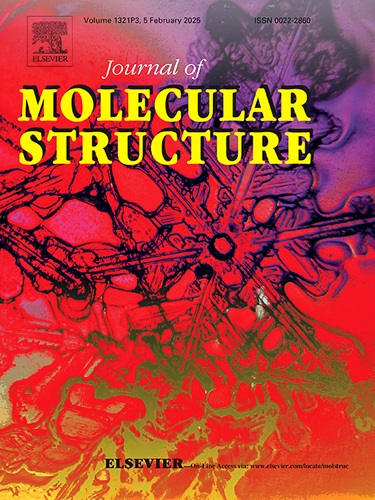Photochromic metal-organic frameworks based on diarylethene: Synthesis, crystal structure and application in coating
IF 4
2区 化学
Q2 CHEMISTRY, PHYSICAL
引用次数: 0
Abstract
A new photochromic diarylethene metal-organic framework material (DMOF), [Cd2(BCM) (4,4′-bipyridine)] (Cd(II)-DMOF), has been synthesized by combining 4,4′-bipyridine and diarylethene H2BCM (H2BCM = 1,2-bis [5-carboxyl-2-methyl-3-thienyl]-3,3,4,4,5,5-hexafluorocyclo1-ene) with Cd(II). The Cd(II)-DMOF is a 6-coordinate orthorhombic crystal system with prism lengths of 9.919 Å (a), 23.809 Å (b) and 11.740 Å (c), and belongs to the Pnna space group. Cd(II)-DMOF exhibits significant color change between colorless and blue when alternately irradiated with Vis and UV light, due to the reversible transformation of its open-ring and closed-ring form of structure. The compact structure of Cd(II)-DMOF enables it to seal N2 in the closed-ring state. However, in the case of the open-ring state of Cd(II)-DMOF with a larger aperture, the N2 is easy to desorb. Doping coating with Cd(II)-DMOF can modify the color by UV and visible light in a very short time, which will extend the possible range of applications.

求助全文
约1分钟内获得全文
求助全文
来源期刊

Journal of Molecular Structure
化学-物理化学
CiteScore
7.10
自引率
15.80%
发文量
2384
审稿时长
45 days
期刊介绍:
The Journal of Molecular Structure is dedicated to the publication of full-length articles and review papers, providing important new structural information on all types of chemical species including:
• Stable and unstable molecules in all types of environments (vapour, molecular beam, liquid, solution, liquid crystal, solid state, matrix-isolated, surface-absorbed etc.)
• Chemical intermediates
• Molecules in excited states
• Biological molecules
• Polymers.
The methods used may include any combination of spectroscopic and non-spectroscopic techniques, for example:
• Infrared spectroscopy (mid, far, near)
• Raman spectroscopy and non-linear Raman methods (CARS, etc.)
• Electronic absorption spectroscopy
• Optical rotatory dispersion and circular dichroism
• Fluorescence and phosphorescence techniques
• Electron spectroscopies (PES, XPS), EXAFS, etc.
• Microwave spectroscopy
• Electron diffraction
• NMR and ESR spectroscopies
• Mössbauer spectroscopy
• X-ray crystallography
• Charge Density Analyses
• Computational Studies (supplementing experimental methods)
We encourage publications combining theoretical and experimental approaches. The structural insights gained by the studies should be correlated with the properties, activity and/ or reactivity of the molecule under investigation and the relevance of this molecule and its implications should be discussed.
 求助内容:
求助内容: 应助结果提醒方式:
应助结果提醒方式:


